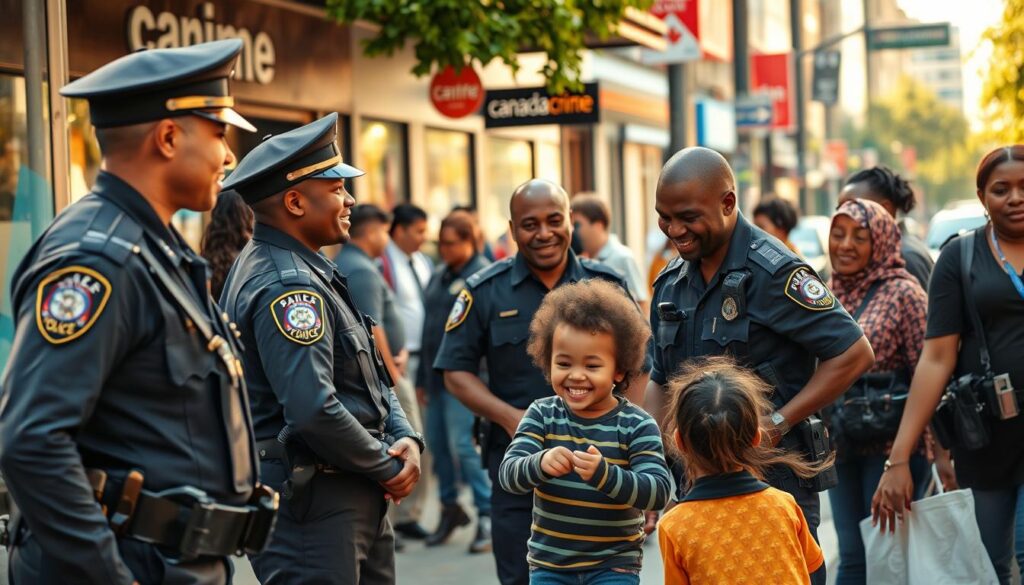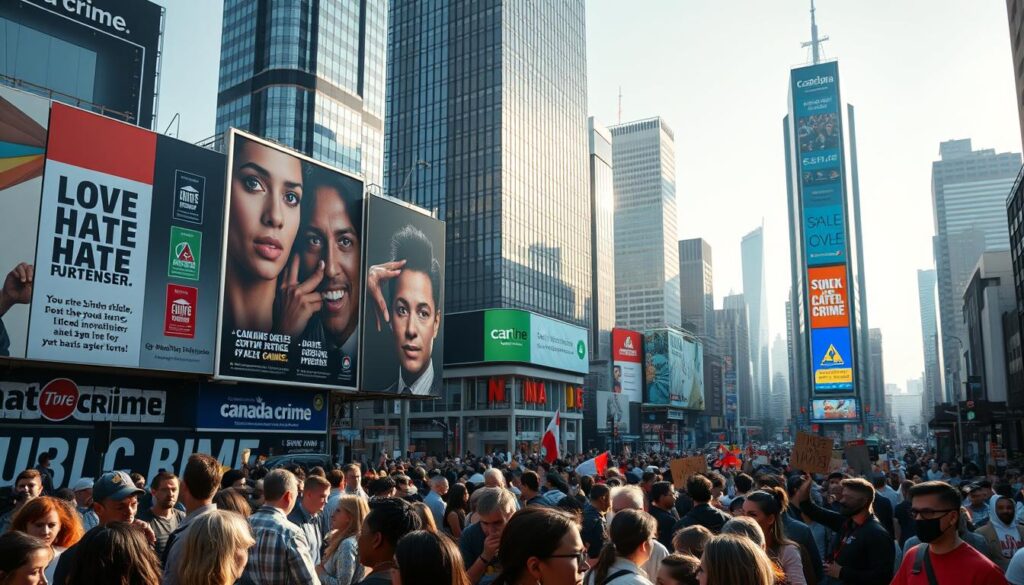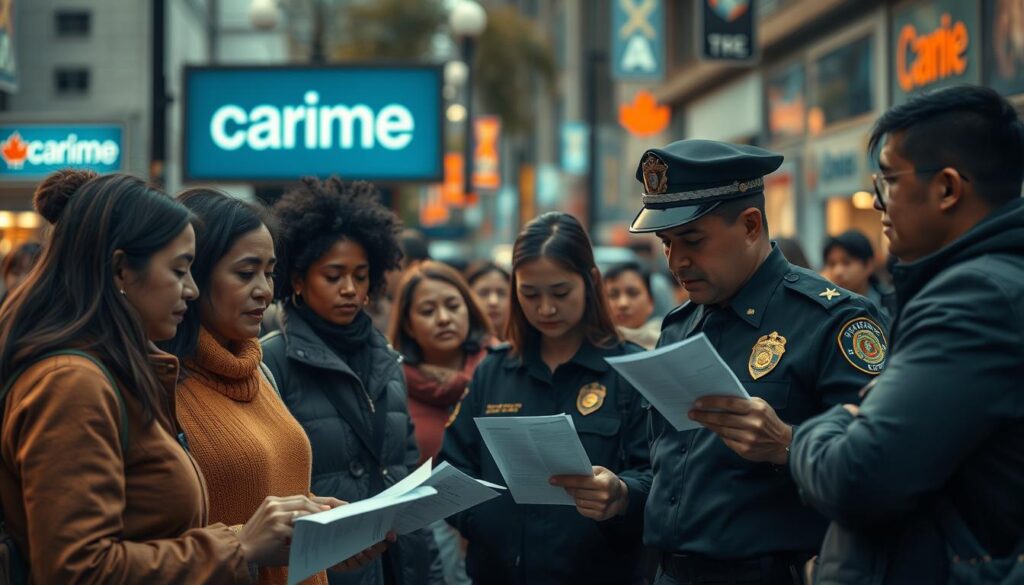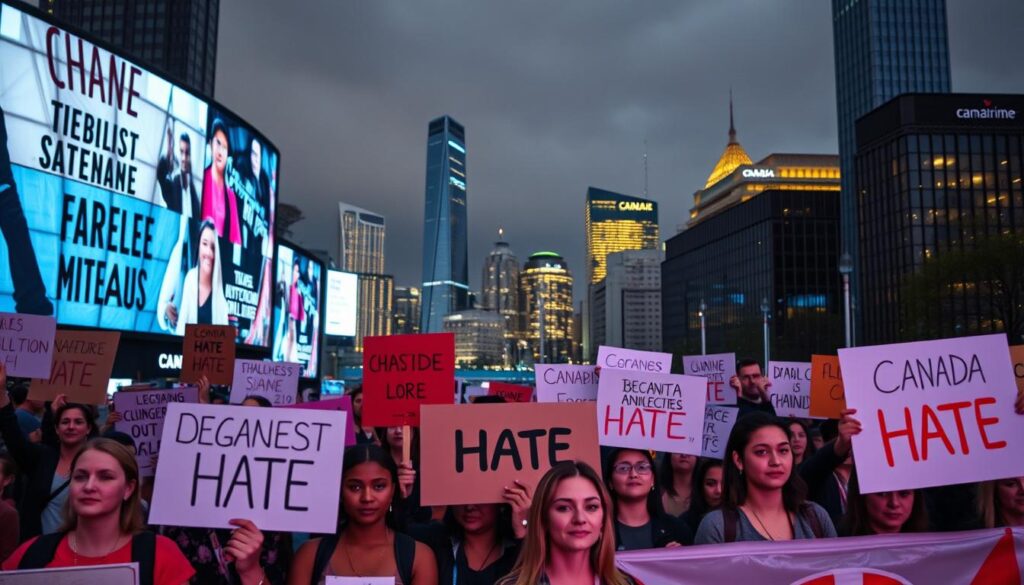From 2004 to 2015, an estimated 250,000 hate crimes happened each year in the United States. This highlights the need to focus on hate crimes prevention and community safety strategies. Canada has also seen an increase in hate crimes recently.
The government of Canada introduced its first major action plan for combating hate crimes. It focuses on empowering communities, building partnerships, and improving data collection. Through the National Anti-Racism Fund and other efforts, it aims to promote multiculturalism and inclusion.
For detailed strategies on preventing hate crimes and more, visit the Department of Justice’s page on hate crimes prevention.
Community involvement and strong local partnerships are key for lasting changes. Community safety strategies make sure everyone feels safe and included. Keep reading to learn how you can help build a hate-free society.
Understanding Hate Crimes in Canada
In Canada, hate crimes are illegal acts against individuals for their race, religion, nationality, or sexual orientation. These crimes can range from physical attacks to spreading hate speech and causing property damage.
What Are Hate Crimes?
Hate crimes in the Canada Crime Code are defined as offenses done out of bias, prejudice, or hatred. Understanding these crimes is important to stop and tackle them effectively. They challenge Canada’s values of diversity and acceptance.
Current Statistics on Hate Crimes in Canada
Statistics Canada has noticed a big increase in police-reported hate crimes lately. There’s a rise in crimes against racial and religious groups. This shows a need for better policies to protect those at risk.
Why Hate Crimes are Increasing
Hate crimes in Canada are rising due to local and global reasons. Understanding these factors helps us know more about hate crimes.
Societal Factors Driving the Rise
Economic issues and unfair treatment based on race are making hate crimes more common. These problems make people frustrated and resentful. At the same time, news coverage that exaggerates these issues can lead to more hate crimes.
The Impact of Global Political Climate
The global political scene affects hate crimes in Canada too. For instance, when leaders or countries promote exclusion or division, it can increase hate crimes. So, we need to tackle hate speech everywhere to stop it from spreading.
Community Policing Strategies
Community policing plays a key role in fighting hate crimes. It builds ties between law enforcement and community groups like schools and civic leaders. This helps build trust and find specific ways to deal with hate crimes.

Building Law Enforcement-Community Partnerships
Strong partnerships are the foundation of effective community policing. Working with community members helps cops understand the special challenges various groups face. This is crucial for preventing hate crimes. Together, they come up with better and lasting ways to tackle hate crimes. Learn more about hate crime trends in.
Using the SARA Model for Problem-Solving
The SARA model stands for Scanning, Analysis, Response, and Assessment. It’s great for pinpointing and solving specific issues in communities. This approach encourages active involvement and finding solutions, which are key in community policing.
By scanning and analyzing, cops can spot trends and root causes of hate crimes. Then, they can come up with and test out specific solutions. This helps prevent hate crimes in the long run.
Implementing Anti-Racism Programs
Creating anti-racism programs is necessary to fight hate crimes and make society more welcoming. These programs need to include educational materials. These materials help people from different backgrounds understand and respect each other.

Educational Resources and Initiatives
Education is key in stopping hate crimes from growing. Places like schools, community centers, and offices can start workshops and classes. These can show how important it is to appreciate everyone’s differences. Programs like these teach how to change wrong ideas and build a kinder community.
The site Canada Crime Statistics and Trends shows why we need anti-racism efforts. They help both kids and adults become more understanding. This leads to less bias and more empathy.
Building an Inclusive Community Culture
Making a culture where everyone feels included involves more than education. It’s about the whole community celebrating different cultures together. Events that show off various cultures, like festivals, are important.
Areas that focus on welcoming everyone tend to see fewer hate crimes. Working towards this goal can really make a difference. For example, Calgary saw more hate crimes reported, improving by 19% since 2021, because of better awareness programs.
By adding anti-racism efforts and educational work into our local areas, we make a big difference. This helps in stopping hate crimes for good.
Tips to Prevent Hate-Motivated Crimes
Stopping hate-motivated crimes takes effort from everyone. It’s about teaching folks and encouraging them to step up when needed. Two key ways are public awareness campaigns and training people to intervene as bystanders.
Public Awareness Campaigns
At the heart of fighting hate crimes is launching wide-reaching public awareness campaigns. These efforts aim to teach everyone about the harm hate crimes do and why they’re wrong. They make people care for each other more, promoting watchfulness and support in all.
Canada’s Action Plan on Combatting Hate sets a good example by backing groups that work against hate. It pushes for fairness, diversity, and inclusion in media and cultural spaces.

Bystander Intervention Training
Bystander intervention training plays a crucial role too. It shows people the right way to step in during hate acts without putting themselves in danger. This not only boosts everyone’s responsibility but also strengthens our united front against hate.
Including this training in public safety plans can make a big difference. For instance, it can support actions by Canada’s National Hate Crimes Task Force and the Canada’s Anti-Racism Strategy 2024-2028.
Reporting and Responding to Hate Incidents
It’s key to have clear ways to report hate crimes to respond well. Knowing how, where to report, and the actions of law enforcement is crucial.
How to Report Hate Crimes
Knowing where to report hate incidents is vital if you see or face one. Communities provide many ways to report, like hotlines, online forms, and local police stations, to make it easy.

- Document the incident with clear details, including date, time, location, and any involved parties.
- Contact local law enforcement immediately to file a report.
- Utilize community support resources for further assistance and emotional support.
Law Enforcement’s Role and Responsibilities
Law enforcement does more than just take reports. Officers get training to deal with these cases calmly and professionally. They use special methods to investigate hate crimes well and support victims.
These methods include working with community groups, creating hate crime units, and launching safety campaigns for the community.
Support Systems for Victims
Help for hate crime victims includes resources and access to crisis and legal support hotlines. It’s vital to help them tackle unique challenges, aid in their recovery, and keep them safe.
Available Resources and Hotlines
In Canada, many groups offer resources for hate crime victims. They offer crisis help, mental health care, and legal assistance. The Canadian Anti-Hate Hotline, for example, supports victims and guides them in reporting hate incidents. Also, services like Ontario’s Victim Support Services or Quebec’s Crime Victims Assistance Centres provide specific aid.

Community Support Networks
Community networks are crucial for helping hate crime victims. They offer peer support, advocacy, and healing. These networks include cooperation between local groups and organizations to offer full care.
Groups like Toronto’s Urban Alliance on Race Relations and Calgary’s Centre for Newcomers show community teamwork. This teamwork helps create a secure environment for everyone. Through community support networks, victims find comfort and strength in their communities.
Emerging Trends and Challenges
In the world of hate crimes, we’re seeing new trends and problems. It’s vital to understand how these changes link with society. We need to grasp the complexities they bring. Now, let’s look at two main points: hate crimes’ intersectionality and the impact of the online world.
Intersectionality in Hate Crimes
Intersectionality is key in getting hate crimes. It looks at how different parts of someone’s identity, like race, gender, and faith, come together. This mix can lead to different forms of hate. For example, a Black Muslim woman might be targeted for her race, religion, and being a woman. This creates a complex issue of discrimination. We must approach this with deep understanding to stop these crimes.
The Role of Online Platforms
Online spots are now where lots of hate speech happens. Social media and other sites help spread harmful words, plan attacks, and share bad ideas quickly. This digital space makes it easier for hate to grow. We need strong monitoring, rules, and community effort to fight hate online.

The internet’s challenges mean tech companies, police, and the community must work together. This will help make the online world safer and more welcoming for all.
Legislation and Policy Enhancements
Canada is working hard to deal with hate crimes through better laws. Canadian hate crime legislation has made good progress in making society safer and more welcoming. By updating laws and introducing new rules, Canada aims to build a strong base to fight hate crimes.

Recent Legal Changes in Canada
In recent times, Canada has made important updates to its Canadian hate crime legislation. These include harsher consequences for hate crimes, better help for victims, and improved ways to report crimes. These steps make sure that wrongdoers face consequences and victims get justice and support. Keeping up with worldwide human rights standards is key to these changes.
Understanding the Canadian Charter of Rights and Freedoms
The Canadian Charter of Rights and Freedoms sets important legal standards for hate crimes. It promises everyone equality and protection from discrimination. New laws are aiming to match the Charter’s guarantees more closely. By understanding and using these rules, police and courts can protect people’s rights more effectively.
Promoting Diversity and Inclusion
Promoting diversity and inclusion helps fight against hate crimes. By using effective diversity training, we can understand different cultures better. Celebrating different cultures through events and programs makes everyone feel respected and included.

Effective Diversity Training Programs
Diversity training programs are key to promoting inclusion. They teach the good points of having a mix of people and cultures. These programs may include workshops and online courses on cultural skills, hidden biases, and how to communicate inclusively. By putting money into these programs, we create a welcoming space and stop hate crimes through understanding and respect.
Celebrating Multiculturalism
Celebrating multiculturalism is vital for diversity and inclusion. Putting on multicultural events, like festivals and cultural fairs, lets communities celebrate together.
These events let people explore different cultures, try various foods, and enjoy cultural performances. Schools can teach students about multiculturalism’s importance, showing them how diversity is valuable. Such celebrations foster inclusivity and respect, building a united society.
The Role of Media in Combating Hate Crimes
The media plays a big role in shaping how we see the world. Media campaigns against hate and responsible media reporting are key in fighting hate crimes.

Positive Media Campaigns
Positive media efforts are vital for spreading the word about hate crimes. Campaigns like CBC’s “Hate Has No Home” and Bell Let’s Talk have helped teach about tolerance. They use real stories, smart messaging, and initiate meaningful conversations.
| Campaign | Goal | Outcome |
|---|---|---|
| Hate Has No Home | Promote Tolerance | Increased Public Awareness |
| Bell Let’s Talk | Mental Health Awareness | Reduced Stigma |
Media’s Responsibility in Reporting
Responsible media reporting means being fair, accurate, and sensitive. Covering hate crimes carefully is vital to avoid spreading fear or wrong information. Reporters should follow guidelines to help their work increase understanding and decrease bias. This way, the media can teach the public and help build a world that doesn’t accept hate.
Conclusion
Fighting hate crimes in Canada needs a plan that includes everyone. This means the government, local groups, schools, and strong laws are important. Every part of our community must help make a place where everyone is safe and respected.
Keeping our communities safe starts with knowing what’s going on and acting early. By using ads to teach everybody how to spot and report hate crimes, we can make a difference. Schools and jobs can also teach people about the value of diversity.
We also need better laws to stop hate crimes and honor everyone’s rights and freedoms. If we all work together and keep learning, Canada can become a place where fewer hate crimes happen. A place where everyone feels safe and included.

